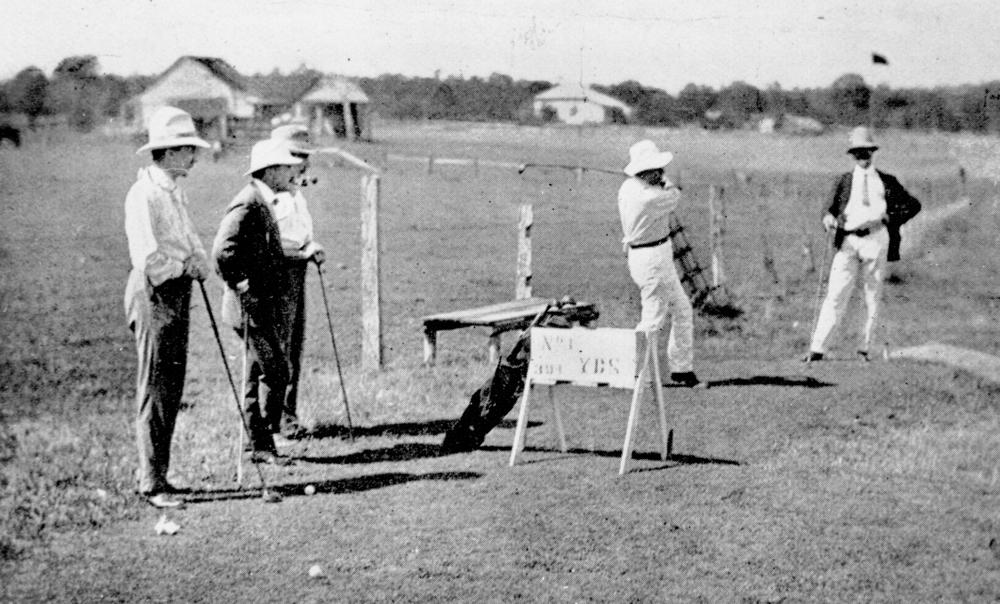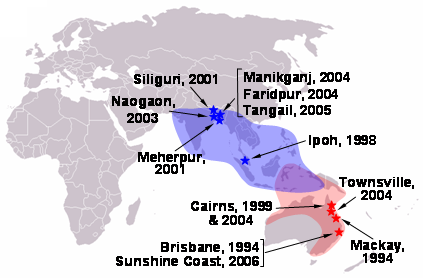|
Animal Research Institute, Yeerongpilly
The Animal Research Institute, Yeerongpilly (ARI) was a government science complex at Yeerongpilly, Queensland, Australia, serving the agricultural sector of Queensland. A number of the Animal Research Institute Buildings are heritage-listed, added to the Queensland Heritage Register in 2008. History The site was proposed and established by Sydney Dodd in 1909 as the Stock Experiment Station for the then Queensland Department of Agriculture and Stock. The land had been occupied in the 19th century by the King family, Parr Smith – headmaster of the Yeronga State School, and A. A. McDiarmid. With Dodd began the site's long-standing contribution to the cattle industry in the protection against tick fever (babesiosis, anaplasmosis). In 1910 the Government Bacteriologist Charles Joseph Pound, inaugural director of the Queensland Stock Institute, took charge of the station for the next 22 years. From 1932 to 1953 the complex was known as the Animal Health Station. In this perio ... [...More Info...] [...Related Items...] OR: [Wikipedia] [Google] [Baidu] |
Yeerongpilly
Yeerongpilly is a southern Suburbs and localities (Australia), suburb in the City of Brisbane, Queensland, Australia. In the , Yeerongpilly had a population of 1,934 people. Geography Yeerongpilly is south-west of the Brisbane GPO. A small section of the north eastern boundary runs along Ipswich Road, Brisbane, Ipswich Road. History Yeerongpilly is an Aboriginal word meaning ''rain coming'' according to Thomas Petrie or is derived from the Indiginous Australians, Aboriginal words ''yurong'' meaning ''rain'' or ''yarung'' meaning ''sandy'' or ''gravelly.'' The suffix ''"pilly"'' means a gully or watercourse. Yeerongpilly grew from an area named Boggo, which was logged for timber for Brisbane. In April 1885, "Lathorn Estate" made up of 118 allotments were advertised to be auctioned by James R. Dickson & Co. A map advertising the auction states the Estate consisted of 118 subdivisions of 131 Portion, Parish of Yeerongpilly. Newspaper advertising states the Estate was "situa ... [...More Info...] [...Related Items...] OR: [Wikipedia] [Google] [Baidu] |
University Of Queensland
, mottoeng = By means of knowledge and hard work , established = , endowment = A$224.3 million , budget = A$2.1 billion , type = Public research university , chancellor = Peter Varghese , vice_chancellor = Deborah Terry , city = Brisbane, Queensland, Australia , students = 55,305 (2019) , undergrad = 35,051 (2019) , postgrad = 19,939 (2019) , faculty = 2,854 , campus = Multiple sites , colours = Purple , affiliations = Group of EightUniversitas 21 ASAIHL EdX , website = , logo = Logo of the University of Queensland.svg , coor = The University of Queensland (UQ, or Queensland University) is a public research university located primarily in Brisbane, the capital city of the Australian state of Queensland. Founded in 1909 by the Queensland parliament, UQ is one of the six sandstone universities, an informal designation of the oldest university in each state. As per 2023, The University of Queensland is ranked as 2nd in Australia and 42nd in the world. Al ... [...More Info...] [...Related Items...] OR: [Wikipedia] [Google] [Baidu] |
Brisbane
Brisbane ( ) is the capital and most populous city of the states and territories of Australia, Australian state of Queensland, and the list of cities in Australia by population, third-most populous city in Australia and Oceania, with a population of approximately 2.6 million. Brisbane lies at the centre of the South East Queensland metropolitan region, which encompasses a population of around 3.8 million. The Brisbane central business district is situated within a peninsula of the Brisbane River about from its mouth at Moreton Bay, a bay of the Coral Sea. Brisbane is located in the hilly floodplain of the Brisbane River Valley between Moreton Bay and the Taylor Range, Taylor and D'Aguilar Range, D'Aguilar mountain ranges. It sprawls across several local government in Australia, local government areas, most centrally the City of Brisbane, Australia's most populous local government area. The demonym of Brisbane is ''Brisbanite''. The Traditional Owners of the Brisbane a ... [...More Info...] [...Related Items...] OR: [Wikipedia] [Google] [Baidu] |
Hendra Virus
Hendra virus (HeV), scientific name ''Hendra henipavirus'', is a bat-borne virus that is associated with a highly fatal infection in horses and humans. Numerous disease outbreaks in Australia among horses have been caused by Hendra virus. The Hendra virus belongs to the genus ''Henipavirus'', which also contains the Nipah virus, which has also caused disease outbreaks. Pathology Flying foxes experimentally infected with the Hendra virus develop a viraemia and shed the virus in their urine, faeces and saliva for approximately one week. There is no other indication of an illness in them. Symptoms of Hendra virus infection of humans may be respiratory, including hemorrhage and edema of the lungs, or in some cases viral meningitis. In horses, infection usually causes one or more of pulmonary oedema, congestion and neurological signs. Ephrin B2 has been identified as the main receptor for the henipaviruses. Transmission Flying foxes have been identified as the reservoir host of Hend ... [...More Info...] [...Related Items...] OR: [Wikipedia] [Google] [Baidu] |
Tuberculosis
Tuberculosis (TB) is an infectious disease usually caused by '' Mycobacterium tuberculosis'' (MTB) bacteria. Tuberculosis generally affects the lungs, but it can also affect other parts of the body. Most infections show no symptoms, in which case it is known as latent tuberculosis. Around 10% of latent infections progress to active disease which, if left untreated, kill about half of those affected. Typical symptoms of active TB are chronic cough with blood-containing mucus, fever, night sweats, and weight loss. It was historically referred to as consumption due to the weight loss associated with the disease. Infection of other organs can cause a wide range of symptoms. Tuberculosis is spread from one person to the next through the air when people who have active TB in their lungs cough, spit, speak, or sneeze. People with Latent TB do not spread the disease. Active infection occurs more often in people with HIV/AIDS and in those who smoke. Diagnosis of active TB is ... [...More Info...] [...Related Items...] OR: [Wikipedia] [Google] [Baidu] |
Brucellosis
Brucellosis is a highly contagious zoonosis caused by ingestion of unpasteurized milk or undercooked meat from infected animals, or close contact with their secretions. It is also known as undulant fever, Malta fever, and Mediterranean fever. The bacteria causing this disease, ''Brucella'', are small, Gram-negative, nonmotile, nonspore-forming, rod-shaped ( coccobacilli) bacteria. They function as facultative intracellular parasites, causing chronic disease, which usually persists for life. Four species infect humans: ''B. abortus'', ''B. canis'', ''B. melitensis'', and ''B. suis''. ''B. abortus'' is less virulent than ''B. melitensis'' and is primarily a disease of cattle. ''B. canis'' affects dogs. ''B. melitensis'' is the most virulent and invasive species; it usually infects goats and occasionally sheep. ''B. suis'' is of intermediate virulence and chiefly infects pigs. Symptoms include profuse sweating and joint and muscle pain. Brucellosis has been recognized in animals and ... [...More Info...] [...Related Items...] OR: [Wikipedia] [Google] [Baidu] |
Leptospirosis
Leptospirosis is a blood infection caused by the bacteria ''Leptospira''. Signs and symptoms can range from none to mild (headaches, muscle pains, and fevers) to severe ( bleeding in the lungs or meningitis). Weil's disease, the acute, severe form of leptospirosis, causes the infected individual to become jaundiced (skin and eyes become yellow), develop kidney failure, and bleed. Bleeding from the lungs associated with leptospirosis is known as severe pulmonary haemorrhage syndrome. More than ten genetic types of ''Leptospira'' cause disease in humans. Both wild and domestic animals can spread the disease, most commonly rodents. The bacteria are spread to humans through animal urine, or water and soil contaminated with animal urine, coming into contact with the eyes, mouth, nose or breaks in the skin. In developing countries, the disease occurs most commonly in farmers and low-income people who live in areas with poor sanitation. In developed countries, it occurs during heavy ... [...More Info...] [...Related Items...] OR: [Wikipedia] [Google] [Baidu] |
Bovine
Bovines (subfamily Bovinae) comprise a diverse group of 10 genera of medium to large-sized ungulates, including cattle, bison, African buffalo, water buffalos, and the four-horned and spiral-horned antelopes. The evolutionary relationship between the members of the group is still debated, and their classification into loose tribes rather than formal subgroups reflects this uncertainty. General characteristics include cloven hooves and usually at least one of the sexes of a species having true horns. The largest extant bovine is the gaur. In many countries, bovid milk and meat is used as food by humans. Cattle are kept as livestock almost everywhere except in parts of India and Nepal, where they are considered sacred by most Hindus. Bovids are used as draft animals and as riding animals. Small breeds of domestic bovid, such as the Miniature Zebu, are kept as pets. Bovid leather is durable and flexible and is used to produce a wide range of goods including clothing and bags. Sy ... [...More Info...] [...Related Items...] OR: [Wikipedia] [Google] [Baidu] |
Epidemiology
Epidemiology is the study and analysis of the distribution (who, when, and where), patterns and determinants of health and disease conditions in a defined population. It is a cornerstone of public health, and shapes policy decisions and evidence-based practice by identifying risk factors for disease and targets for preventive healthcare. Epidemiologists help with study design, collection, and statistical analysis of data, amend interpretation and dissemination of results (including peer review and occasional systematic review). Epidemiology has helped develop methodology used in clinical research, public health studies, and, to a lesser extent, basic research in the biological sciences. Major areas of epidemiological study include disease causation, transmission, outbreak investigation, disease surveillance, environmental epidemiology, forensic epidemiology, occupational epidemiology, screening, biomonitoring, and comparisons of treatment effects such as in clinical trials. ... [...More Info...] [...Related Items...] OR: [Wikipedia] [Google] [Baidu] |
Veterinary Pathology
Veterinary pathologists are veterinarians who specialize in the diagnosis of diseases through the examination of animal tissue and body fluids. Like medical pathology, veterinary pathology is divided into two branches, anatomical pathology and clinical pathology. Other than the diagnosis of disease in food-producing animals, companion animals, zoo animals and wildlife, veterinary pathologists also have an important role in drug discovery and safety as well as scientific research. Veterinary anatomical pathology Anatomical pathology (''Commonwealth'') or ''Anatomic pathology'' (''U.S.'') is concerned with the diagnosis of disease based on the gross examination, microscopic, and molecular examination of organs, tissues, and whole bodies (necropsy). The Indian, European, Japanese and American Colleges of Veterinary Pathologists certify veterinary pathologists through a certifying exam. The American College of Veterinary Pathologist certification exam consists of four parts - gro ... [...More Info...] [...Related Items...] OR: [Wikipedia] [Google] [Baidu] |
Peter C
Peter may refer to: People * List of people named Peter, a list of people and fictional characters with the given name * Peter (given name) ** Saint Peter (died 60s), apostle of Jesus, leader of the early Christian Church * Peter (surname), a surname (including a list of people with the name) Culture * Peter (actor) (born 1952), stage name Shinnosuke Ikehata, Japanese dancer and actor * ''Peter'' (album), a 1993 EP by Canadian band Eric's Trip * ''Peter'' (1934 film), a 1934 film directed by Henry Koster * ''Peter'' (2021 film), Marathi language film * "Peter" (''Fringe'' episode), an episode of the television series ''Fringe'' * ''Peter'' (novel), a 1908 book by Francis Hopkinson Smith * "Peter" (short story), an 1892 short story by Willa Cather Animals * Peter, the Lord's cat, cat at Lord's Cricket Ground in London * Peter (chief mouser), Chief Mouser between 1929 and 1946 * Peter II (cat), Chief Mouser between 1946 and 1947 * Peter III (cat), Chief Mouser between 1947 a ... [...More Info...] [...Related Items...] OR: [Wikipedia] [Google] [Baidu] |







